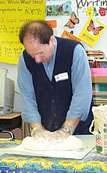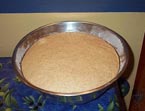Recipe
 |
 |
 |
 |
 |
 |
 |
Go
to
printable recipes.
 |
Kneading |
 |
 |
 |
Punching
down |
For more recipes, see the cookbook section of the Reading List
Honey Whole-Wheat Bread Recipe
This
is the basic recipe used in my workshops.
For a printable version of this and
other delicious bread recipes please click on the links at the bottom
of the page.
Ingredients:
1. 'Proofing the yeast': Pour the packet of yeast into the 1/2 cup of lukewarm water, add the honey and mix gently. Set mixture aside for 5 - 10 minutes. Small bubbles will form a foam on the surface of the mixture if the yeast are sufficiently active. If no foam appears start over with a new packet of yeast.
(Note: While this step isn't absolutely necessary, it is helpful for insuring success as it will verify that the yeast are adequately alive to make the dough rise.)2. Mixing: ) While the yeast is proofing, mix the dry ingredients together in a large mixing bowl and then add the water and oil and stir. When the yeast mixture has bubbled add it and stir thoroughly. The dough should be slightly sticky and form into a ball-like shape. (If necessary adjust the consistency by adding a little more water or flour).
3.Kneading: Put the dough on a floured surface and knead for 10 - 15 minutes. Kneading involves a pressing/pushing and folding motion.
(Note: Kneading is easy to learn but may require a demonstration from someone you know. Perhaps you have a relative or neighbor who can show you how.)
Add a little flour (very gradually) whenever the dough mass becomes very sticky. As a result of kneading the dough becomes elastic. It is sufficiently kneaded when an indentation made by pressing the dough springs back automatically.4. Fermentation or 1st Rising: Pour approx. 2 tsp. canola or corn oil into the mixing bowl and then place the ball of dough in the bowl and rub it in the oil. Turn the dough over (the top should now be coated with oil - this will prevent it from drying out) and then cover the bowl with plastic wrap or a cloth. Leave the bowl in a warm spot (75 - 80 degrees) until it doubles in size - approx. 1 1/2 hours.
5. Punching down/Shaping of loaves/ 2nd Rising: Gently push down on the dough; it will collapse as the carbon dioxide that has inflated it is released.
(Note: while called "punching down," the force of a punch is not really required).
Cut the dough into two equal pieces and shape for the 9"x5" loaf pan - stretching the surface of the dough so the top of each loaf is very smooth. Grease the pans with oil before placing the dough. Cover the pans with a cloth or plastic wrap and leave in a warm spot to rise for 30 - 45 minutes.6. Baking: Preheat the oven to 375 degrees. Bake the loaves for 20 minutes and then rotate them in the oven if they are browning unevenly. Bake for another 20 - 25 minutes until loaves are a nice light brown on top.
(Note: A finished loaf will sound hollow when tapped on the bottom after being removed from the loaf pan).7. Cooling and eating: Remove the loaves from the loaf pans and place on a cooling rack for at least 15 minutes. Once cooled, slice and enjoy!
More recipes for the home baker:
These are some of my favorite recipes. When you click on the link, the recipe file will open* and can easily be printed out.
* The files are in pdf format so you'll need Acrobat Reader (a free program) to open them. If you don't have Reader you can download it by clicking on this link: Get Adobe Reader
Basic Honey Whole-Wheat or White Bread
Challah (A Delicious Egg Bread)
Oatmeal-Wheat Bread
Walnut-Currant Bread
© 2005 Gary M. Gomer